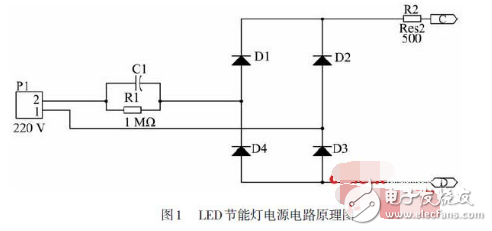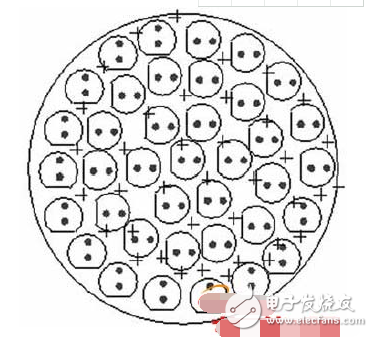LEDs, also known as crystal light-emitting diodes, are diodes made of gallium (Ga) and arsenic (AS) and phosphorus (P) compounds. Currently, LEDs and corresponding drive circuits are used to produce energy-saving street lamps, office and electronic products. Widely used, LED energy-saving lamps use high-brightness straw-hat type white-emitting LEDs as illuminants, which have the advantages of high luminous efficiency, low power consumption, long life, and environmental protection. It is the ideal illumination cold light source in the future and is the future home lighting. The preferred choice of light source.
Energy-saving lamps have great advantages compared with commonly used incandescent lamps and fluorescent lamps. The luminous efficiency of LED energy-saving lamps is over 90%, the luminous efficiency of ordinary incandescent lamps is only about 20%, and that of ordinary fluorescent lamps is only about 40%, so LED energy-saving lamps The utility model has the advantages of remarkable high efficiency and energy saving; the LED energy-saving lamp LED flows through the direct current, the brightness of the light is constant, and there is no light flickering phenomenon, which is beneficial to protect the user's vision and has the eye-protecting function.
The lamp contains no harmful substances, which is good for recycling, healthy and environmentally friendly. Because there is no ultraviolet and infrared rays in the spectrum of LED energy-saving lamps, the spectrum is pure, so LED energy-saving lamps have no radiation and do not generate heat. Lights emitted from light sources such as fluorescent lamps contain ultraviolet rays and infrared rays, and have high temperature, high power consumption, and are easily damaged.
LED energy saving lamp worksFigure 1 is a schematic diagram of the power supply circuit of 38 LED lamps. The lamp is powered by a 220V AC power supply. The 220V AC power is firstly stepped down by the C1 and R1 resistors, and then rectified by the full bridge of D1~D4. Resistor R2 provides a constant current supply to the 38 LEDs in series. The rated current of the LED is 20mA and the power is about 2W. The LED lamp adopts a self-heating method, because the LED is more and more concentrated, so the current should not be too large in the circuit design.

In Figure 1, R1 is the protection resistor, R2 is the current limiting resistor to prevent the voltage from rising and the temperature rises. The current of the LED increases. This circuit is most suitable for small power lamp cups, which is small in size and can be conveniently installed in a small space. In the light cup. The circuit has the advantages of low power consumption, small size, and economical utility. In design, the step-down capacitor C1 is preferably a polyester capacitor with a withstand voltage of 400V or higher, and the current limiting resistor is generally a 1/4W color ring resistor.
2, component parametersC1 uses 474μF, 400V polyester capacitor, R1 uses 1MΩ five-color ring resistor, D1-D4 uses IN4007 rectifier diode, R2 uses 510 ohm 1/4W color ring resistor, LED adopts straw hat type high brightness white light 38 diodes.
3, the production process(1) Before starting the production, all the electronic components used must be tested with a multimeter to prevent the damaged components from being mixed inside, causing unnecessary circuit failure. Especially LEDs, because they are all connected in series, if one is damaged, the circuit will not be made successfully. LED testing requires the use of a multimeter R & TImes; 10k block, the same measurement method as the ordinary diode, can not be detected with other ranges.
(2) Welding DC drive circuit board. Diodes, resistors and other components are selected for horizontal installation. Capacitors and other components should be installed vertically.
(3) Soldering LED boards, the LED arrangement rules are shown in Figure 3.

image 3
The LED arrangement should be neat and tidy, especially the polarity of the LED pins should not be installed incorrectly. The identification of the LED pin can be judged according to the length of the LED pin. The method is “long positive and negative negativeâ€. One of the easiest ways to do this is to simply mount the LED in the direction of the notch, then solder it with a suitable soldering iron, and finally cut off the excess component pins with a diagonal pliers.
(4) Soldering AC power leads (with AC mark), LED power leads (marked with +, - marks).
(5) Fix the DC drive circuit board to the lamp cup with hot melt adhesive, and insert the LED light board into the lamp cup along the card slot to fix the back cover.
Intelligent LV switchgear cabinet combines the intelligent power distribution monitoring terminal with the Internet of Things to realize data acquisition and intelligent connection, wherein the intelligent power distribution monitoring terminal monitors the status of power distribution equipment as well as the voltage, current, power and energy of the power distribution loop in real time, realizes the local monitoring of operating status via the HMI interface, so as to realize the local and remote comprehensive management of the LV power distribution system.
Intelligent Lv Switchgear,Low Voltage Switchgear,Low Voltage Switchgear For Distribution,Low Voltage Switchgear Panel
Jiangsu Sfere Electric Co., Ltd , https://www.elecnova-global.com